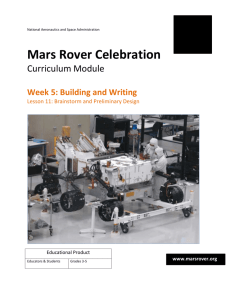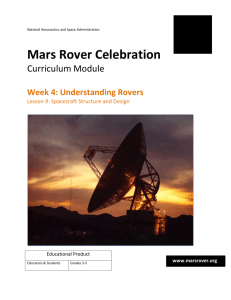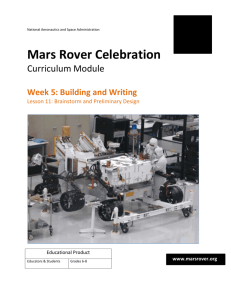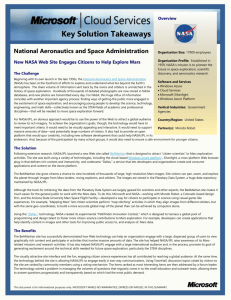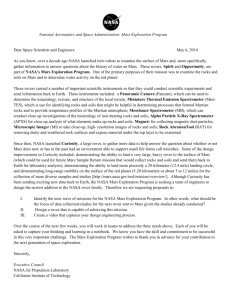Lesson 6: mission measurements
advertisement
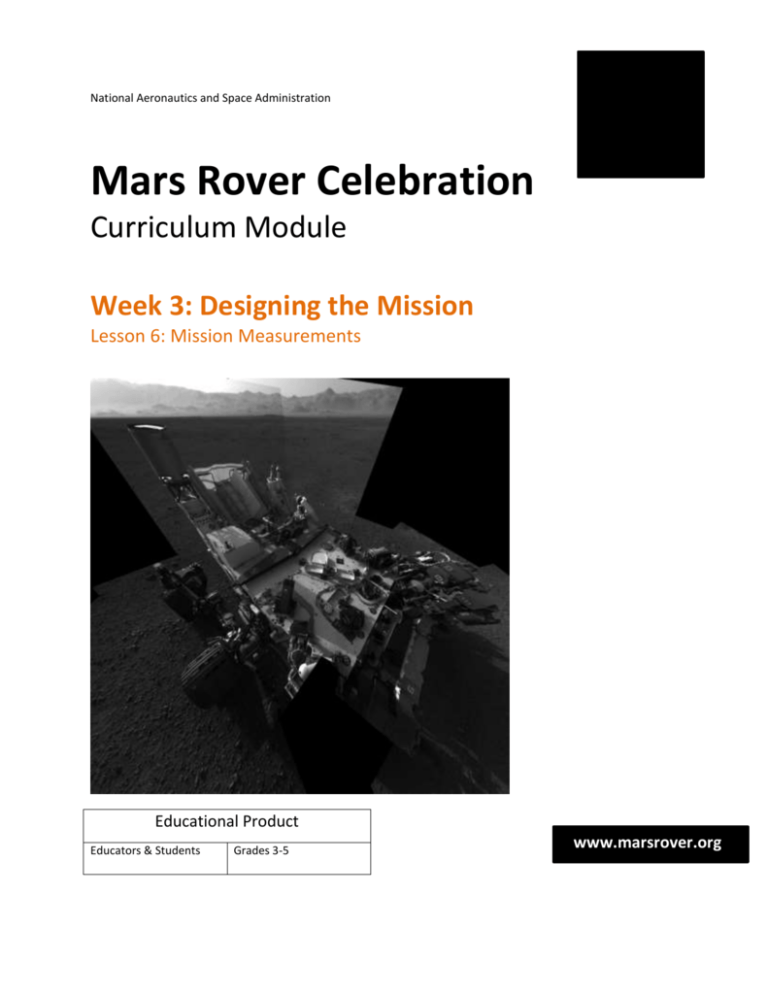
National Aeronautics and Space Administration Mars Rover Celebration Curriculum Module Week 3: Designing the Mission Lesson 6: Mission Measurements Educational Product Educators & Students Grades 3-5 www.marsrover.org Week 3: Designing the Mission LESSON 6: GRADE LEVEL: MATERIALS: MISSION MEASUREMENTS 3-5 Team Charts (from Lesson 5) TEKS/SES: Science Grade 3 3.2.A 3.4.A 3.5.A Grade 4 4.2.A 4.4.A 4.5.A Grade 5 5.2.B 5.4.A Full text versions of these TEKS are available at http://ritter.tea.state.tx.us/rules/tac/chapter112/ch112a.html Language Arts Grade 3 3.4 3.20 3.20.A.i 3.20.C Grade 4 4.2. 4.2.A Grade 5 5.2. 5.2.A 3.25.A 3.29.A 3.31 4.18 4.18.A.i 4.18.C 4.23.A 4.27.A 4.29 5.18 5.18.A.i 5.18.C 5.23.A 5.27.A 5.29 Full text versions of these TEKS are available at http://ritter.tea.state.tx.us/rules/tac/chapter110/ch110a.html NATIONAL STANDARDS Science Science as Inquiry Abilities necessary to do scientific inquiry Understanding about scientific inquiry Science and Technology Abilities of technological design Understanding about science and technology History and Nature of Science Science as human endeavor 2 Mars Rover Model Celebration – Lesson Plan; Week 3; Lesson6 – Grades 3-5 Nature of science History of science Math Data Analysis and Probability Formulate questions that can be addressed with data and collect, organize, and display relevant data to answer them Language Arts NL-ENG.K-12.4 COMMUNICATION SKILLS Students adjust their use of spoken, written, and visual language (e.g., conventions, style, vocabulary) to communicate effectively with a variety of audiences and for different purposes. NL-ENG.K-12.5 COMMUNICATION STRATEGIES Students employ a wide range of strategies as they write and use different writing process elements appropriately to communicate with different audiences for a variety of purposes. NL-ENG.K-12.7 EVALUATING DATA Students conduct research on issues and interests by generating ideas and questions, and by posing problems. They gather, evaluate, and synthesize data from a variety of sources (e.g., print and nonprint texts, artifacts, people) to communicate their discoveries in ways that suit their purpose and audience. NL-ENG.K-12.12 APPLYING LANGUAGE SKILLS Students use spoken, written, and visual language to accomplish their own purposes (e.g., for learning, enjoyment, persuasion, and the exchange of information). ESSENTIAL QUESTION: Why is it important to write your scientific question so you can answer it using data? LESSON OBJECTIVE(S): Students will be able to: Refine their scientific question so that it can be answered by data and/or modeling Brainstorm possible solutions for the scientific question chosen Determine reasonableness of solutions Use concept maps to enhance meaningful learning ENGAGEMENT 1. 2. 3. 4. Use the attached documents (Appendix), present the Key Vocabulary and the Essential Question for students to consider during the lesson. Ask students to recall their scientific questions that they created in the last lesson. Today students will brainstorm possible solutions to their questions. To start, tell students that you have been wondering about Saturn and you developed a scientific question to answer. Draw a concept map on the board. A sample concept map is located in the Appendix. Walk students through the thought process of brainstorming possible solutions to the scientific question. While progressing through the concept map, remember to continue an “internal dialogue” (Lesson 2) modeling the process for students and asking questions: How might that happen? Does it make sense? Have I thought it through? 3 Mars Rover Model Celebration – Lesson Plan; Week 3; Lesson6 – Grades 3-5 What else could happen? Is this possible or reasonable? EXPLORATION Students will work with their teams to answer their own scientific question using the concept map in their Science Notebooks. The teacher should circulate as students work assisting when necessary. The teacher should also challenge students to come up with reasonable plausible solutions. To further probe students’ understanding or guide students back on track if necessary, use the following question starters: o Why….? o How….? o Have you considered….? o Does that sound reasonable….? o How did you conclude that….? EXPLANATION Once students have completed their concept maps, draw their attention back to the chart papers that they began during Lesson 5. Have students complete their chart papers by transferring the information from their concept maps to their chart paper. Teams may elect to simply copy the concept map or display the same information in a different format. ELABORATION If time allows, students may share their concept maps with the class and allow their classmates to ask questions about the solutions that each team brainstormed. Students may also continue to brainstorm more possible solutions for their scientific questions. EVALUATION During this two day lesson, the teacher is encouraged to use formative assessments to determine and deepen student understanding. Teachers may wish to use one or both of the included exit tickets (located in the Appendix) after the conclusion of the first day or review and/or grade students’ Science Notebooks to establish student understanding. SUPPLEMENTAL RESOURCES Mars Missions: http://mars.jpl.nasa.gov/ http://mars.jpl.nasa.gov/mer/ http://mars.jpl.nasa.gov/MPF/index1.html http://mars.jpl.nasa.gov/msl/ http://mars.jpl.nasa.gov/msp98/lander http://mars.jpl.nasa.gov/programmissions/ http://marsrovers.jpl.nasa.gov/home/index.html http://www.planetary.org/explore/space-topics/space-missions/missions-to-mars.html KEY VOCABULARY FOR STUDENTS measurement plausible solution 4 Mars Rover Model Celebration – Lesson Plan; Week 3; Lesson6 – Grades 3-5 Additional Vocabulary for Students falsify prediction validate VOCABULARY FOR TEACHERS infer model 5 Mars Rover Model Celebration – Lesson Plan; Week 3; Lesson6 – Grades 3-5 APPENDIX TEKS Details http://marsrover.phys.uh.edu/curriculum/Gr35/Lesson_06/Lesson6_35_TEKS.docx Essential Question http://marsrover.phys.uh.edu/curriculum/Gr35/Lesson_06/Lesson6_35_EssentialQuestion.docx Exit Ticket http://marsrover.phys.uh.edu/curriculum/Gr35/Lesson_06/Lesson6_35_ExitTicket.docx Science Notebook http://marsrover.phys.uh.edu/curriculum/Gr35/Lesson_06/Lesson6_35_SciNotebook.docx Vocabulary Definitions for Students http://marsrover.phys.uh.edu/curriculum/Gr35/Lesson_06/Lesson6_35_Definitions.docx Vocabulary Definitions for Teachers http://marsrover.phys.uh.edu/curriculum/Gr35/Lesson_06/Lesson6_35_Teacher_Definitions.docx Vocabulary Cards o Measurement http://marsrover.phys.uh.edu/curriculum/Gr35/Lesson_06/Lesson6_35_VocabCard_Measureme nt.pdf o Plausible http://marsrover.phys.uh.edu/curriculum/Gr35/Lesson_06/Lesson6_35_VocabCard_Plausible.pd f o Solution http://marsrover.phys.uh.edu/curriculum/Gr35/Lesson_06/Lesson6_35_VocabCard_Solution.pdf Sample Concept Map o Description http://marsrover.phys.uh.edu/curriculum/Gr35/Lesson_06/Lesson6_SampleConceptMap.pdf o Sample http://marsrover.phys.uh.edu/curriculum/Gr35/Lesson_06/Lesson6_SampleConceptMap.pptx Additional NASA Resources for Teachers http://phoenix.lpl.arizona.edu/pdf/lesson_9.pdf http://solar-center.stanford.edu/webcast/wcpdf/sun&stars5-8.pdf#page=15 http://stargazers.gsfc.nasa.gov/pdf/activities/in_a_different_light/lesson6_student.pdf http://www.images-press.com/_files/lessonPlan_marsby.pdf 6 Some photographs and graphics are used with the permission of the National Aeronautics and Space Administration. The remaining photographs and illustrations were purchased through clipart.com. All elements of the Site, including the Jupiterimages Content, are protected by copyright, trade dress, moral rights, trademark and other laws relating to the protection of intellectual property. 7
